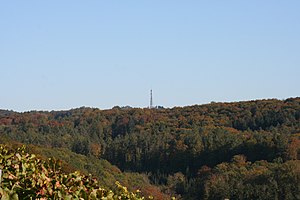Löwensteiner and Heilbronn mountains
|
FFH area
"Löwensteiner and Heilbronner Berge" |
||
|
The Stocksberg near Löwenstein in the FFH area "Löwensteiner und Heilbronner Berge", 2007 |
||
| location | District of Heilbronn and Hohenlohekreis | |
| Identifier | DE-7021-341 | |
| WDPA ID | 555521779 | |
| Natura 2000 ID | DE7021341 | |
| FFH area | 54.427 km² | |
| Geographical location | 49 ° 6 ' N , 9 ° 22' E | |
|
|
||
| Setup date | 2004 | |
| administration | Regional Council Stuttgart | |
The FFH area Löwensteiner and Heilbronner Berge is a protected area (protected area identifier DE-7021-341) in the district of Heilbronn and in the district of Heilbronn and registered by ordinance of 2004 by the Stuttgart regional council according to Directive 92/43 / EEC (Fauna-Flora-Habitat Directive) Hohenlohe district in Baden-Württemberg . The FFH area is part of the European Natura 2000 network of protected areas . With the ordinance of the regional council of Stuttgart on the definition of areas of community importance of October 30, 2018, the protected area was established.
description
The FFH area comprises two caves , large closed beech forests with parts of other tree species (including spruce ) in the Keuper Hills , the Löwensteiner Mountains and the Heilbronn edge heights , some with strong relief from brook valleys.
Protection purpose
The following habitat types according to Annex I of the Habitats Directive occur in the area:
- Tufa springs
- Species-rich bristle grass lawn
- Lean, lowland hay meadows
- Limestone cliffs with crevice vegetation
- Mixed ravine and hillside forests
- Old acidic oak forests on sandy soils with English oak
- Alder, ash and softwood alluvial forests
- Bedstraw-oak-hornbeam forests
- Star chickweed oak hornbeam forests
- Silicate rocks with crevice vegetation
- Caves that are not open to tourists
- Grove beech forests
- Woodruff beech forests
- Orchid-lime-beech forests
- Dry heaths
- Running waters with flooding aquatic vegetation
- Nutrient-poor to moderately nutrient-rich, calcareous still waters with chandelier algae
- Natural and near-natural nutrient-rich still waters with spawning or frog-bite communities
See also
Web links
- Profile of the FFH area Löwensteiner and Heilbronner Berge in the protected area directory of the LUBW
Individual evidence
- ↑ a b c BfN: 7021-341 Löwensteiner and Heilbronner Berge (FFH area) . Online at www.bfn.de. Retrieved March 20, 2019.

